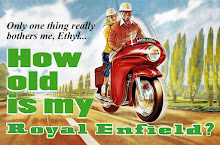 |
| Feast your eyes on the photographs of this custom Royal Enfield Bullet. |
The pictures of his custom Royal Enfield Bullet are stunning, but Marco Möller, a German living in Dubai, says "the project will never be finished, ever."
How much farther can he go? It's remarkable how far he has come, starting with a Bullet so far gone Marco writes that "It wasn't love at first sight, it was merely pity!" Here's his story:
"About two years ago I met HER, my Royal Enfield Bullet 500, made in 1994. She was carelessly put down in my former bosses’ front yard, covered in grease and dust, oil stains all over her body. Poor thing totally abandoned and parched by the desert sun!
 |
| Note the effect of the brass parts and engraved aluminum. |
"One man’s trash another man’s treasure!
"When I brought her home, she was black and chrome, strained by rust. Since I was no expert on motorcycles whatsoever, it proved to be quite a task getting the Old Lady started at first. Finding someone, capable of curing my Indian beauty’s soul here in Dubai was almost impossible; until I met the guys from “Classic Motorcycles” at a bike show.
"They had just opened their new showroom with a workshop and happened to be the new local Enfield dealer. I’m telling you, these guys are good! They definitely know their babies by heart and stand behind their workmanship! I was back in business!
(There's an article in Dubai's
The National showing Marco consulting with a mechanic at Classic Motorworks.)
 |
| Wheels are smaller than stock. |
"I finally got my engine fixed and learned a whole lot about my Bullet. Now I had two options: restoring an original or modifying something my way and making it my first very own project.
"I stripped her down to almost nothing, trying to imagine how she’d suit me best. It took several turns to become what I had in mind; a wicked blend of details. Unfolding every single layer of her I could clearly see right through her.
"In order to give her, a smaller appearance I’ve reduced the size of the front wheel from 19 to 18 inches and the rear wheel to 15 inches. A friend translated my vision of brown and beige into action; in fact he did a marvelous paint job.
 |
| More brass, and leather. |
"The handle bar and the grips are wrapped with leather strips, which I also used to cover the seat. I’ve customized some parts myself, bought quite a few of brass pieces in India and started to engrave all of them by hand using hammer and chisel.
"Engraving the larger aluminum parts took me an insane amount of time, and it’s by far and away not finished yet.
 |
| Clean, understated, yet elegant tail. |
"I guess you cannot put my modified Bullet in any category like bobber, chopper, cafe or anything else. However it was very critical that I maintained the basic features of a typical Royal Enfield as those are indeed what make her special and remarkable.
"I do enjoy it when people ask questions about the bike. But if anyone asks me, she’s not a show bike! She’s much more than that! She’s loud and furious, she’s moody and temperamental, she’s so much fun to ride! She’s always changing, but always the same."
 |
| The starting place. |

























































